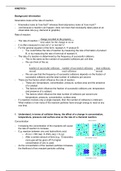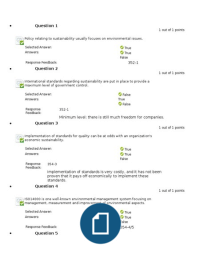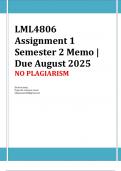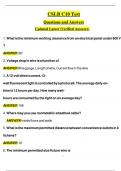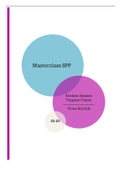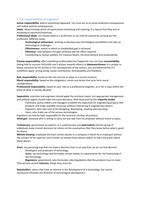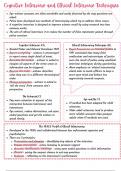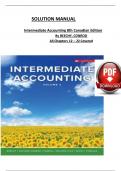KINETICS I
Background information
Kinematics looks at the rate of reaction.
- Kinematics looks at ‘how fast?’ whereas thermodynamics looks at ‘how much?’
- Just because a reaction can happen, does not mean that necessarily takes place at an
observable rate (e.g. diamond to graphite)
Rate of reaction
change recorded in the property
- The rate of reaction =
time taken for the change to occur
- It is often measured in mol cm3 s-1 or mol dm3 s-1
- For the general equation of the form: reactant A product B
o You could follow the rate of reaction by measuring the rate of formation of product
B, or by measuring the rate of removal of reactant A.
- The rate of a reaction is determined by the frequency of successful collisions.
o This is the same as the number of successful collisions per unit time.
o We can think of this as:
number of successful collisions number of successful collisions total collisions
= x
second total collisions second
o We can see that the frequency of successful collisions depends on the fraction of
successful collisions and the total number of collisions per second.
- There are five factors which influence the rate of reaction.
o These are: temperature, concentration, pressure, surface area and the presence
of a catalyst.
o The factors which influence the fraction of successful collisions are: temperature
and presence of a catalyst.
o The factors which influence the total number of collisions per second are:
temperature, pressure, concentration, surface area.
- If a reaction involves only a single reactant, then the number of collisions is irrelevant.
What matters is how many of the reactant particles have enough energy to react at any
one time.
1. Understand, in terms of collision theory, the effect of a change in concentration,
temperature, pressure and surface area on the rate of a chemical reaction.
Concentration
- Increasing the concentration of the reactants will cause
the rate of reaction to increase.
- E.g. reaction between zinc and hydrochloric acid:
o Zn (s) + HCl (aq) ZnCl2 (aq) + H2 (g)
o After a certain amount of time (e.g. 10 seconds),
more gas will be given off if a higher
concentration of zinc is used.
- As the concentration of the reactant particles increases,
the likelihood of two reactant particles colliding
, KINETICS I
increases so the frequency of collisions increases. The number of successful collisions
per unit time increases so the rate of reaction increases.
When the concentration may not increase the rate of a chemical reaction:
- When a catalyst is already working at its maximum rate:
o Suppose you are using a small amount of a solid catalyst in a reaction, and a
high enough concentration of reactant in solution so that all the catalyst particles
are working as quickly as they can all the time.
o Increasing the concentration of the solution further will have no effect, as the
catalyst is already working at its maximum capacity.
- In certain multi-step reactions:
o This is the more important effect from an A Level point of view.
o Suppose you have a reaction which happens in a series of small steps. These
steps are likely to have widely different rates – some fast, some slow.
o For example, suppose reactants A and B react together in these two stages:
A X + Y (a very slow reaction)
X + B Z (a very fast reaction)
o The overall rate of the reaction is going to be governed by how fast A splits up to
make X and Y.
This is described as the rate determining step of the reaction.
o If you increase the concentration of A, you will increase the chances of this step
happening and so will likely increase the overall rate of reaction.
o If you increase the concentration of B, the rate of the second step will speed up,
but it makes very little difference to the overall rate.
o A good example of this is the SN1 nucleophilic substitution reaction between a
tertiary halogenoalkane and a nucleophile (e.g. OH-).
Temperature
- Increasing the temperature of the reactants will cause the rate of reaction to increase.
- Increasing the temperature will raise the average kinetic energy of the particles. This
increases rate of reaction in two ways:
o The number of collisions between reactant particles will increase. This is
because, as the particles have more kinetic energy, they will move faster and so
will collide more frequently.
o The proportion of collisions which are successful will increase. This is because,
as the particles have more kinetic energy, a greater proportion of the particles will
have energy greater than the activation energy needed for the reaction to occur.
Therefore a greater proportion of collisions will result in a successful reaction.
See the Maxwell-Boltzmann Distribution.
- Combined, this leads to the number of successful collisions
occurring per unit time increasing. This means that the rate of
reaction will increase.
- The graph on the right shows how the rate constant of a
reaction varies with temperature.
Pressure
- Increasing the pressure of the reactants will cause the
rate of reaction to increase.
Background information
Kinematics looks at the rate of reaction.
- Kinematics looks at ‘how fast?’ whereas thermodynamics looks at ‘how much?’
- Just because a reaction can happen, does not mean that necessarily takes place at an
observable rate (e.g. diamond to graphite)
Rate of reaction
change recorded in the property
- The rate of reaction =
time taken for the change to occur
- It is often measured in mol cm3 s-1 or mol dm3 s-1
- For the general equation of the form: reactant A product B
o You could follow the rate of reaction by measuring the rate of formation of product
B, or by measuring the rate of removal of reactant A.
- The rate of a reaction is determined by the frequency of successful collisions.
o This is the same as the number of successful collisions per unit time.
o We can think of this as:
number of successful collisions number of successful collisions total collisions
= x
second total collisions second
o We can see that the frequency of successful collisions depends on the fraction of
successful collisions and the total number of collisions per second.
- There are five factors which influence the rate of reaction.
o These are: temperature, concentration, pressure, surface area and the presence
of a catalyst.
o The factors which influence the fraction of successful collisions are: temperature
and presence of a catalyst.
o The factors which influence the total number of collisions per second are:
temperature, pressure, concentration, surface area.
- If a reaction involves only a single reactant, then the number of collisions is irrelevant.
What matters is how many of the reactant particles have enough energy to react at any
one time.
1. Understand, in terms of collision theory, the effect of a change in concentration,
temperature, pressure and surface area on the rate of a chemical reaction.
Concentration
- Increasing the concentration of the reactants will cause
the rate of reaction to increase.
- E.g. reaction between zinc and hydrochloric acid:
o Zn (s) + HCl (aq) ZnCl2 (aq) + H2 (g)
o After a certain amount of time (e.g. 10 seconds),
more gas will be given off if a higher
concentration of zinc is used.
- As the concentration of the reactant particles increases,
the likelihood of two reactant particles colliding
, KINETICS I
increases so the frequency of collisions increases. The number of successful collisions
per unit time increases so the rate of reaction increases.
When the concentration may not increase the rate of a chemical reaction:
- When a catalyst is already working at its maximum rate:
o Suppose you are using a small amount of a solid catalyst in a reaction, and a
high enough concentration of reactant in solution so that all the catalyst particles
are working as quickly as they can all the time.
o Increasing the concentration of the solution further will have no effect, as the
catalyst is already working at its maximum capacity.
- In certain multi-step reactions:
o This is the more important effect from an A Level point of view.
o Suppose you have a reaction which happens in a series of small steps. These
steps are likely to have widely different rates – some fast, some slow.
o For example, suppose reactants A and B react together in these two stages:
A X + Y (a very slow reaction)
X + B Z (a very fast reaction)
o The overall rate of the reaction is going to be governed by how fast A splits up to
make X and Y.
This is described as the rate determining step of the reaction.
o If you increase the concentration of A, you will increase the chances of this step
happening and so will likely increase the overall rate of reaction.
o If you increase the concentration of B, the rate of the second step will speed up,
but it makes very little difference to the overall rate.
o A good example of this is the SN1 nucleophilic substitution reaction between a
tertiary halogenoalkane and a nucleophile (e.g. OH-).
Temperature
- Increasing the temperature of the reactants will cause the rate of reaction to increase.
- Increasing the temperature will raise the average kinetic energy of the particles. This
increases rate of reaction in two ways:
o The number of collisions between reactant particles will increase. This is
because, as the particles have more kinetic energy, they will move faster and so
will collide more frequently.
o The proportion of collisions which are successful will increase. This is because,
as the particles have more kinetic energy, a greater proportion of the particles will
have energy greater than the activation energy needed for the reaction to occur.
Therefore a greater proportion of collisions will result in a successful reaction.
See the Maxwell-Boltzmann Distribution.
- Combined, this leads to the number of successful collisions
occurring per unit time increasing. This means that the rate of
reaction will increase.
- The graph on the right shows how the rate constant of a
reaction varies with temperature.
Pressure
- Increasing the pressure of the reactants will cause the
rate of reaction to increase.

